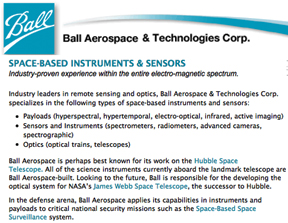 [SatNews] Ball Aerospace & Technologies Corp. is part of a team selected to build the first...
[SatNews] Ball Aerospace & Technologies Corp. is part of a team selected to build the first...
...space-based instrument to monitor major air pollutants across the North American continent for NASA’s Tropospheric Emissions: Monitoring of Pollution (TEMPO) mission. Led by the Smithsonian Astrophysical Observatory, Cambridge, Mass., the TEMPO team will build a geostationary ultraviolet-visible (UV-VIS) spectrometer to continuously measure ozone, aerosols and other trace gases over greater North America. The geostationary position of the instrument will allow delivery of regional, hourly readouts of atmosphere data during daylight hours. This data will advance air quality research on how air pollution affects climate change and air quality on a continental scale.
“While Ball is at the forefront of low Earth orbit instrument development, the TEMPO spectrometer will be the company’s first geostationary instrument for NASA,” said Cary Ludtke, vice president and general manager for Ball’s Civil and Operational Space business unit. “TEMPO takes advantage of our expertise and technology developed for previous ultraviolet-visible instruments that have already flown or are currently on orbit.”
Those instruments include the Ozone Mapping Profiler Suite (OMPS) flying aboard the nation’s newest climate and weather satellite, Suomi NPP, and the Stratospheric Aerosol and Gas Experiment (SAGE). The sophisticated optical system built by Ball Aerospace for the James Webb Space Telescope relies on the same UV-VIS heritage. NASA anticipates the TEMPO instrument will catch a ride on a commercial communications satellite as a hosted payload when it is completed in September 2017. Mission costs will be capped at $90 million, excluding the launch vehicle and integration to the selected satellite platform.

